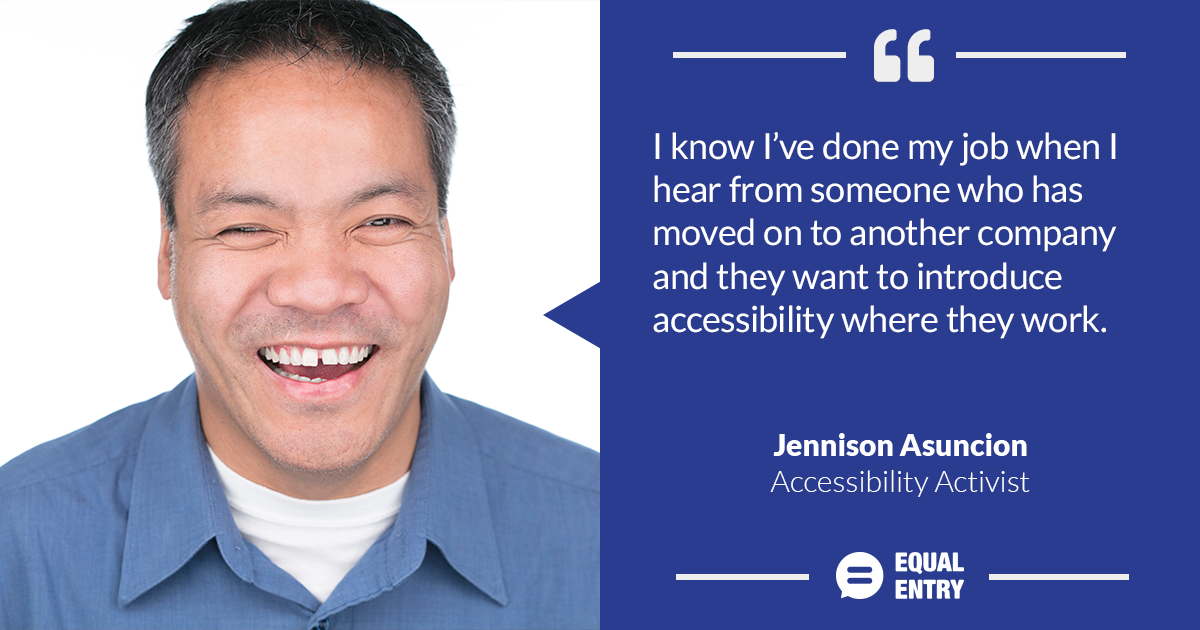Summary

How did you get started in accessibility?
The summer after graduating from high school, I had the opportunity to participate in a program called SCORE (Summer Computer Opportunities in Recreation and Education) run by the CNIB. This program brought together blind and visually impaired youth from across Canada together to expose us to different adaptive hardware and software. Observing others who had never had a chance to use technology such as screen magnification software or a Braille display before, was a profound experience for me. Inspired by SCORE, throughout college, I volunteered, training students with different disabilities how to use computers. As I began grad school, I worked as a research assistant and then became co-director of the Adaptech Research Network which conducts research, in part, on the impact of technology on the lives of Canadian college and university students with disabilities/impairments.
Fast-forward to 2006, having spent time as an eLearning developer and a Project Manager, I was looking for a career change to something where I felt I could have some meaningful impact And thought that the time was right to consider digital accessibility as a full-time career. Thanks to Richard Aubrey at the Royal Bank of Canada, I got my first full-time gig working in digital accessibility at the end of that year, and here I am now, with a dream-job in accessibility at LinkedIn in the Silicon Valley.
In your 12+ years sharing knowledge and best practices with colleagues, how would you describe your experience in collaborating with engineers and designers in the field who are new to or unfamiliar with accessibility and inclusive design?
Nine times out of ten, it’s been a positive experience for me, and an eye-opening one for my colleagues. Engineers and designers typically react with curiosity, once they understand how people with different disabilities/impairments interact with sites and apps, and the issues faced when these are not designed and built to be accessible and inclusive to all types of users. I have to say – it’s when they get to observe issues happening first-hand, namely, watching someone with a disability/impairment interacting with a site or app, rather than simply reading a spec, that’s when the magic happens. From there, colleagues want to make sure what they build and design is usable and accessible. I know I’ve done my job when I hear from someone who has moved on to another company or they’ve heard me speak somewhere and they want to introduce accessibility where they work.
You co-founded Global Accessibility Awareness Day (GAAD) in 2012 which is observed annually on the third Thursday of May. What was your intention in creating this day of observation and how has it increased awareness of accessibility issues?
The intent of Global Accessibility Awareness Day has always been to raise the visibility of digital access and inclusion especially among mainstream tech pros who don’t necessarily spend their time thinking about or addressing themselves to such issues. The hope, of course, is that people participate in GAAD and will leave wanting to become part of the solution. It has certainly grown beyond our initial aspiration to something both Joe Devon, GAAD’s other Co-Founder and I, ever thought, both in the number and different types of activities that take place marking GAAD. Joe and I are amazed that we are fast approaching GAAD’s 10th anniversary.
One way Joe and I measure the impact of GAAD is seeing a year-by-year increase in the number of events taking place (both public and internally at companies, schools and other organizations), as well as a steady increase in the number of these taking place in non-English speaking countries. We also obtain Twitter metrics. The number of mentions/references keep increasing every year over Twitter, and more so now on Facebook and LinkedIn too.
What is an accessibility barrier that you would like to see solved?
I travel frequently and one thing I’ve encountered on specific models of both Boeing and Airbus aircraft is that the flight attendant call button is inaccessible. It is recessed either in the panel above the seat or on the in-seat touch-screen. On a recent Dreamliner light, it was pointed out that one had to in fact access this functionality via an on-screen menu. Without any screen reading capability built-in to the seat-back entertainment system, the menu itself was not accessible to me.
Twice in my many years of flying, the flight attendant affixed a piece of tape over said button, once they realized, as someone who is completely blind, that I couldn’t find or use it. The majority of the time though, flight attendants are caught off-guard when they perform their safety briefing with me when they discover the issue. I am honestly surprised this accessibility gap has not been raised with air transportation authorities and the aircraft manufacturers because to me, this is not only a significant accessibility issue, it is also a safety issue. How is anyone who cannot find and use the call button supposed to receive assistance from a flight attendant? Asking your seat mate for help or calling out randomly for assistance are neither acceptable nor dignified alternatives.
The story Jennison told here about the flight attendant who put a piece of tape over the call button reminds me of the time a nurse did the exact same thing just after my most recent kidney transplant back in 2001. Nice interview.
In the interview, the inaccessibility of the call buttons on flights is discussed and I completely agree as Flight attendants have had to show me where these buttons are when flying the friendly skies. We see braille and large tactile numbers in elevators. What can we do or who can we contact to develop a universal system for the accessibility of medical equipment? Hospital beds and monitors that display a patient’s vital information are inaccessible. My experience is recent as I have had two loved ones in the Hospital in the last six months.